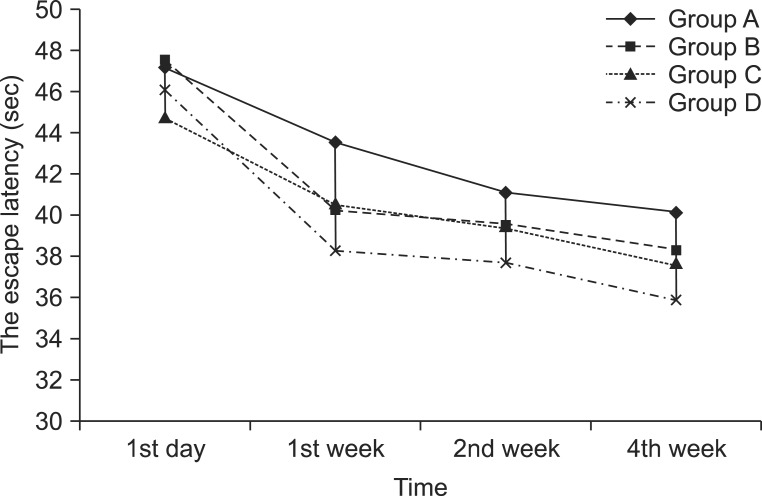1. Moon SK, Shin YI, Kim HI, Lee MC, Jin CY, Lee S, Yoon KH, Cai QY, Chung GH. Chronological changes in cerebral infarction of photochemical thrombosis model: magnetic resonance imaging and histopathological correlation. J Korean Acad Rehabil Med. 2006; 30:447–454.
2. Dirnagl U, Iadecola C, Moskowitz MA. Pathobiology of ischaemic stroke: an integrated view. Trends Neurosci. 1999; 22:391–397. PMID:
10441299.

3. Balduini W, De Angelis V, Mazzoni E, Cimino M. Simvastatin protects against long-lasting behavioral and morphological consequences of neonatal hypoxic/ischemic brain injury. Stroke. 2001; 32:2185–2191. PMID:
11546915.

4. Shake JG, Peck EA, Marban E, Gott VL, Johnston MV, Troncoso JC, Redmond JM, Baumgartner WA. Pharmacologically induced preconditioning with diazoxide: a novel approach to brain protection. Ann Thorac Surg. 2001; 72:1849–1854. PMID:
11789759.
5. Zanelli SA, Solenski NJ, Rosenthal RE, Fiskum G. Mechanisms of ischemic neuroprotection by Acetyl-L-carnitine. Ann N Y Acad Sci. 2005; 1053:153–161. PMID:
16179519.

6. Acetyl-L-Carnitine. Monograph. Altern Med Rev. 2010; 15:76–83. PMID:
20359271.
7. Kidd PM. A review of nutrients and botanicals in the integrative management of cognitive dysfunction. Altern Med Rev. 1999; 4:144–161. PMID:
10383479.
8. White HL, Scates PW. Acetyl-L-carnitine as a precursor of acetylcholine. Neurochem Res. 1990; 15:597–601. PMID:
2215852.

9. Kiraly MA, Kiraly SJ. The effect of exercise on hippocampal integrity: review on recent research. Int J Psychiatry Med. 2005; 35:75–89. PMID:
15977946.
10. Cotman CW, Berchtold NC, Christie LA. Exercise builds brain health: key roles of growth factor cascades and inflammation. Trends Neurosci. 2007; 30:464–472. PMID:
17765329.

11. Ang ET, Dawe GS, Wong PT, Moochhala S, Ng YK. Alteration in spatial learning and memory after forced exercise. Brain Res. 2006; 1113:186–193. PMID:
16904660.
12. Watson BD, Dietrich WD, Busto R, Wachtel MS, Ginsberg MD. Induction of reproducible brain infarction by photochemically initiated thrombosis. Ann Neurol. 1985; 17:497–504. PMID:
4004172.

13. Morris RG, Garrud P, Rawlins JN, O'Keefe J. Place navigation impaired in rats with hippocampal lesions. Nature. 1982; 297:681–683. PMID:
7088155.

14. Sun Y, Oberley LW, Li Y. A simple method for clinical assay of superoxide dismutase. Clin Chem. 1988; 34:497–500. PMID:
3349599.

15. Draper HH, Hadley M. Malondialdehyde determination as index of lipid peroxidation. Methods Enzymol. 1990; 186:421–431. PMID:
2233309.
16. Rogers HJ. Cell death and organ development in plants. Curr Top Dev Biol. 2005; 71:225–261. PMID:
16344107.

17. Elinos-Calderón D, Robledo-Arratia Y, Pérez-De La Cruz V, Pedraza-Chaverrí J, Ali SF, Santamaría A. Early nerve ending rescue from oxidative damage and energy failure by L-carnitine as post-treatment in two neurotoxic models in rat: recovery of antioxidant and reductive capacities. Exp Brain Res. 2009; 197:287–296. PMID:
19565224.

18. Yin YY, Liu H, Cong XB, Liu Z, Wang Q, Wang JZ, Zhu LQ. Acetyl-L-carnitine attenuates okadaic acid induced tau hyperphosphorylation and spatial memory impairment in rats. J Alzheimers Dis. 2010; 19:735–746. PMID:
20110616.

19. Ueno Y, Zhang N, Miyamoto N, Tanaka R, Hattori N, Urabe T. Edaravone attenuates white matter lesions through endothelial protection in a rat chronic hypoperfusion model. Neuroscience. 2009; 162:317–327. PMID:
19409967.

20. Balduini W, De Angelis V, Mazzoni E, Cimino M. Simvastatin protects against long-lasting behavioral and morphological consequences of neonatal hypoxic/ischemic brain injury. Stroke. 2001; 32:2185–2191. PMID:
11546915.

21. Barhwal K, Hota SK, Jain V, Prasad D, Singh SB, Ilavazhagan G. Acetyl-l-carnitine (ALCAR) prevents hypobaric hypoxia-induced spatial memory impairment through extracellular related kinase-mediated nuclear factor erythroid 2-related factor 2 phosphorylation. Neuroscience. 2009; 161:501–514. PMID:
19318118.

22. Barhwal K, Singh SB, Hota SK, Jayalakshmi K, Ilavazhagan G. Acetyl-L-carnitine ameliorates hypobaric hypoxic impairment and spatial memory deficits in rats. Eur J Pharmacol. 2007; 570:97–107. PMID:
17610872.

23. Forloni G, Angeretti N, Smiroldo S. Neuroprotective activity of acetyl-L-carnitine: studies in vitro. J Neurosci Res. 1994; 37:92–96. PMID:
7908343.

24. Ando S, Tadenuma T, Tanaka Y, Fukui F, Kobayashi S, Ohashi Y, Kawabata T. Enhancement of learning capacity and cholinergic synaptic function by carnitine in aging rats. J Neurosci Res. 2001; 66:266–271. PMID:
11592123.

25. Annadurai T, Vigneshwari S, Thirukumaran R, Thomas PA, Geraldine P. Acetyl-L-carnitine prevents carbon tetrachloride-induced oxidative stress in various tissues of Wistar rats. J Physiol Biochem. 2011; 67:519–530. PMID:
21618017.

26. Suzuki M, Katamine S, Tatsumi S. Exercise-induced enhancement of lipid peroxide metabolism in tissues and their transference into the brain in rat. J Nutr Sci Vitaminol. 1983; 29:141–151. PMID:
6886836.

27. Radak Z, Asano K, Inoue M, Kizaki T, Oh-Ishi S, Ohno H. Acute bout of exercise does not alter the antioxidant enzyme status and lipid peroxidation of rat hippocampus and cerebellum. Pathophysiology. 1995; 2:243–245.

28. Davies KJ, Quintanilha AT, Brooks GA, Packer L. Free radicals and tissue damage produced by exercise. Biochem Biophys Res Commun. 1982; 107:1198–1205. PMID:
6291524.

29. Radak Z, Kaneko T, Tahara T, Nakamoto H, Ohno H, Sasvari M, Nyakas C, Goto S. The effect of exercise training on oxidative damage of lipids, proteins, and DNA in rats skeletal muscle: evidence for beneficial outcomes. Free Radic Biol Med. 1999; 27:69–74. PMID:
10443921.
30. Somani SM, Ravi R, Rybak LP. Effect of exercise training on antioxidant system in brain regions of rat. Pharmacol Biochem Behav. 1995; 50:635–639. PMID:
7617712.
31. Radak Z, Kaneko T, Tahara S, Nakamoto H, Pucsok J, Sasvari M, Nyakas C, Goto S. Regular exercise improves cognitive function and decreases oxidative stress in rat brain. Neurochem Int. 2001; 38:17–23. PMID:
10913684.
32. van Praag H, Shubert T, Zhao C, Gage FH. Exercise enhances learning and hippocampal neurogenesis in aged mice. J Neurosci. 2005; 25:8680–8685. PMID:
16177036.

33. Ra SM, Kim H, Jang MH, Shin MC, Lee TH, Lim BV, Kim EH, Kim KM, Kim SS. Treadmill running and swimming increase cell proliferation in the hippocampal dentate gyrus of rats. Neurosci Lett. 2002; 333:123–126. PMID:
12419496.

34. van Praag H, Kemperamann G, Gage FH. Running increases cell proliferation and neurogenesis in the adult mouse dentate gyrus. Nature Neurosci. 1999; 2:266–270. PMID:
10195220.






 PDF
PDF ePub
ePub Citation
Citation Print
Print







 XML Download
XML Download